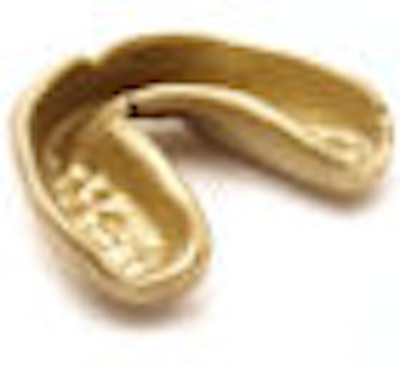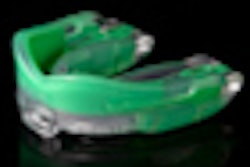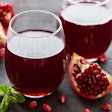
The secret to athletic success may be lurking in the dentist's office. The lowly mouthguard, once scorned by professional athletes, is becoming the hot new sports accessory, due to studies suggesting that it not only protects an athlete's teeth, but it can possibly prevent concussions and even enhance performance.
New research shows that athletes are stronger, have more endurance, and even jump higher when they wear specially designed mouthguards. While the studies are small, mostly unpublished, and partially funded by mouthguard companies, athletes are already clamoring to get the devices.
"We've begun to fit 50 Major League Baseball players this year," said Mark Roettger, D.D.S., an assistant dental professor at the University of Minnesota who consults for Bite Tech, one of the main companies that makes performance-enhancing mouthguards.
Pure Power Athletics, Bite Tech's chief rival and maker of the Pure Power mouthguard, also boasts a star-studded client list, including Manny Ramirez of the Los Angeles Dodgers, former Dallas Cowboys wide receiver Terrell Owens, and PGA golfer Scott McCarron.
Even nonathletes are showing interest, said Dr. Roettger, a past president of the Academy for Sports Dentistry. One woman wore a custom mouthguard to her two-day master's degree exam and said she felt "more clear and lucid" during the test, he said.
The sudden enthusiasm marks a sea change for the dental profession, which has struggled for decades to convince sports enthusiasts to wear mouthguards. "When you tell people, 'This might protect your teeth,' they tend to not listen," Dr. Roettger said.
The advantages of subtly shifting jaw alignment have been hinted at for centuries. The Romans bit leather straps as they went into battle. Native American women bit on sticks during childbirth. And the expression "bite the bullet" came from the Civil War, when soldiers literally bit on bullets to endure the pain of limb amputation in the days before anesthesia, Dr. Roettger said.
Fast forward to 2008 when researchers swung an anvil at a highly engineered mannequin, then measured the forces that undulated through its head. The head received a blow that was 120 times the force of gravity, well above the 98 g-forces (g) that cause concussions. When Bite Tech's Edge mouthguard was put in the mannequin, the blow to the head dropped to 92 g, Dr. Roettger said, stressing that this was an unpublished pilot study.
It's unclear why the Edge would reduce the g-forces. But researchers suspect it may involve the repositioning of the jaw, the cushioning materials in the device, or some combination of the two.
It also isn't clear how mouthguards might enhance performance. Pure Power Athletics and Bite Tech have completely different views on how the devices work -- and how they should be made.
Pure Power Athletics says it designs its mouthguards according to the principles of neuromuscular dentistry, focusing on getting the jaw in its optimal alignment. Bite Tech, by contrast, concentrates more on the body's endocrine system, examining how changes in jaw position can alter the production of stress hormones.
To make the Pure Power mouthguard, neuromuscular dentists analyze each patient's bite extensively, measuring the electrical activity of the facial muscles with electromyography for as long as 1.5 hours. The goal: to find the jaw's most relaxed position, a position that less than 10% of the population finds naturally, according to the company. With the jaw completely relaxed, the spine is under less stress, the company contends, and people find they have more energy.
The performance mouthguard, worn on only the lower teeth in noncontact sports, can cost as much as $2,000. But it's a price that many athletes seem more than willing to pay, with more than 1,500 now wearing them.
Earlier this year, Pure Power Athletics released an unpublished study of 22 athletes, comparing those who wore their devices with others wearing more traditional mouthguards. The research, conducted at Rutgers University, found that athletes wearing the mouthguard jumped significantly higher than their counterparts and also had significantly higher anaerobic peak power.
Bite Tech, meanwhile, found in its own unpublished research that athletes who wore its mouthguards had 20% stronger grips, 17% more endurance, and 25% less lactic acid in their systems.
Dr. Roettger has been trying to figure out why the mouthguard could have such a big impact. The answer, he believes, involves hormonal changes that occur when animals bite on objects in stressful situations.
A Japanese experiment with rats showed how much biting on objects can reduce cortisol, a steroid hormone released by the adrenal glands in response to stress. In the study, published in the Journal of Dental Research (February 2004, Vol. 83:2, pp. 124-128), scientists stressed 48 rats by strapping them to wooden boards and putting them on their backs. Some of the rats were given sticks to bite on while they were restrained. After the test, scientists found the rats that bit sticks for an hour had 53% fewer neurons in their brain secreting corticotropin-releasing factor, a substance that stimulates the production of cortisol.
Reducing cortisol has clear benefits to athletes. The stress hormone increases muscle breakdown and blocks the body's efforts to repair damaged tissues.
The Academy for Sports Medicine has also found that athletes miss visual cues when they are stressed -- for instance, not seeing a ball traveling in their field of peripheral vision.
Clearly, a lot more research needs to be done to figure out whether mouthguards can become a panacea for so much that ails athletes. In the meantime, Dr. Roettger hopes that athletes will at least wear one of the devices already on the market.
The worst it could do is protect their teeth.
Copyright © 2009 DrBicuspid.com



















